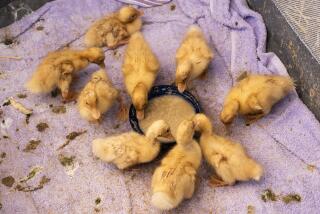Webfoot Patrol : Farming: A Fillmore citrus grower uses a flock of ducks to control snails. Some of his neighbors are even trying the idea.
- Share via
The latest weapon in the war against nature’s pests in the farming community of Fillmore is Tom Wilson’s flock of ducks.
Wilson has hundreds of them. And he uses them to keep his citrus orchards free of snails.
The ducks do such a good job of snail removal that Wilson has started loaning them out to other farms. Sometimes he has even swapped them for something he needs, like the use of a tractor.
The slender, bearded Wilson decided to acquire his ducks when his 30-acre orange grove became dangerously thick with an ever-increasing snail population.
“Snails are a real nuisance. They can cause a lot of damage to an orchard,” he lamented. “They’ll climb the trees and scar up the fruit.”
Poisons were not an option for Wilson because he is an organic farmer. He turned to the ducks when other biological control methods failed.
“I’ve known that ducks eat snails for a long time,” he said. “So I just decided ‘I’m going to try it. I’ll give them a chance to clean out the orchard.’ ”
The ducks made their initial snail sweep in mid-December. “This has been more successful than I ever could have imagined. I was pretty much snail free in just a few months. (Poisons) could not have worked better.”
In fact, the web-footed snailbusters proved so proficient at consuming the pests, Wilson was confronted with a quandary of a different kind.
“Without snails, I have nothing to feed them,” he said. “You can’t imagine how expensive it would be to feed all of them.”
His solution? Loan the ducks out--or even barter their services--to area citrus growers, also burdened by an overabundance of snails.
His ducks--the snow white Pekin species noticeable by its rotund girth--get a free plentiful meal, yet remain readily available to Wilson for future snail onslaughts.
“I just got the ducks to take care of my own snail problems--not to specifically run ducks,” he said. “I went in with the idea ‘Well, I could just sell them all off for meat when it was all done.’ ”
Yes, he did eat one or two.
“Rice and curry with duck is real good,” Wilson said.
Wilson’s fellow citrus growers say they are impressed with what they have seen so far from the surviving members of the flock.
“It’s the only sensible way to control snails,” said Carpinteria farmer Steve Moore. He put an order in for 100 of Wilson’s ducks to clean out 35 acres of his lemon trees. “They cleaned up the snails so fast we’re having a hard time keeping them.”
Though seemingly perfect for pest maintenance on small acreage, ducks prove to be too labor-intensive for larger growers, however, according to Dave Machlitt, a citrus and avocado integrated pest management consultant.
“(Ducks) are a pretty novel approach. Its use isn’t widespread,” Machlitt said. “There’s a lot of work involved, but it can work tremendously to adaptable situations.”
Wilson’s ordered his ducks in mid-November from a farm in Northern California. He paid $1 each for 600 of them, half for him and half for a neighbor, Gary Ball, who also uses his ducks to eradicate snails.
It wasn’t long before the U. S. Postal Service came knocking on Wilson’s front door, a noisy special delivery in hand.
“They were delivered in 2-feet-by-2-feet cardboard flats that were a few inches high. You wouldn’t believe the chirping going on inside there,” he said.
The downy, yellow ducklings were reared in chain-link, lamp-heated pens--complete with a solar-powered, anti-coyote shock line--for about five weeks before Wilson put them to work.
“By mid-winter I was bringing the ducks into the orchard for an hour in the morning and again in the early evening,” he said. “I just herd them around and let ‘em go. They know right where the snails are.
“They put their heads down underneath the leaves and just walk along, eating at an incredible pace. It’s amazing how many they eat--hundreds at a feeding for one duck. They’re just eatin’ fools.”
Soon after feeding, Wilson explained, the snow-white ducks lazily waddle around, content with doing as little as possible.
“They eat so much that their gullets get incredibly big and so full--it looks really comical,” Wilson said.
Danger lurks, though, in the otherwise tranquil, well-vegetated rolling hills overlooking the Santa Clara Valley. The flightless Pekins are easy prey for predators eyeing Wilson’s feathered bounty.
“I’m with them the whole time they’re out in the orchard,” Wilson said. “The coyotes get them. One time I came in for a drink of water and was in for about five minutes. But when I went back out, there were six dead ducks.”
“You always have to be watching over them,” said Bardsdale citrus grower John Wise. “It’s definitely labor-intensive.”
When Wilson was in need of a tractor to take care of some odds and ends around his ranch, Wise stepped in to exchange his Caterpillar and services for some of Wilson’s ducks.
“At first I was real skeptical. I used them in two 10-acre blocks and the ducks cleaned it right up.”
Wise soon began to use the ducks on larger acreage and now he’s sold on the idea.






